UPSC Daily Current Affairs: 8th July 2024 | Current Affairs & Hindu Analysis: Daily, Weekly & Monthly PDF Download
GS2/Polity
Rules on Expulsion of Speech in the Parliament
Source: The Hindu

Why in News?
Recently, parts of speeches by some Opposition politicians in Parliament were removed, sparking a debate about actions taken by the Speaker and the Chairman of the Rajya Sabha. This involved speeches by Congress leader Rahul Gandhi and Congress President Mallikarjun Kharge. Both were speaking during the customary Motion of Thanks to the President for her address to Parliament, a practice borrowed from the British Parliament. Speeches are generally political and the Chair never insists on relevance.
About Article 105 of the Constitution:
Article 105 of the Constitution gives Members of Parliament (MPs) the right to speak freely in the House without interference from the courts. This freedom is one of the most important privileges of an MP, but it must follow the rules of the House.
Expunging Words:
- Rules for Removing Words:
- Effect of Expunging:
Rules for Removing Words:
Rule 380 of the Lok Sabha and Rule 261 of the Rajya Sabha allow the presiding officers to remove any words from the debate that are defamatory, unparliamentary, undignified, or indecent.
Effect of Expunging:
Once words are removed, they do not remain on record. Publishing these words afterward can lead to legal consequences.
Making Allegations:
- Procedure for Allegations: Rule 353 of the Lok Sabha explains the procedure when an MP wants to make an allegation against another MP or an outsider. The MP must give advance notice to the Speaker and the concerned Minister before making the allegation.
- Inquiry: The Minister will investigate the allegation and present the facts when the MP makes the allegation in the House.
- Types of Allegations: This rule only applies to allegations that are defamatory or incriminatory. If the allegation is not defamatory or incriminatory, this rule does not apply.
Allegations Against Ministers:
- Freedom to Question Ministers: MPs can freely question and make allegations against government Ministers because the Council of Ministers is accountable to Parliament. This ensures the government's accountability.
- Freedom of Speech: Article 105 protects MPs' freedom of speech in the House, allowing them to perform their duties without fear. In summary, MPs have significant freedom to speak and question within the House, but there are rules to maintain decorum and ensure accountability.
Past Instances: When an MP wants to make an allegation against a Minister or the Prime Minister, they must follow specific procedures set by previous Speakers. This is because such allegations are serious matters.
Relation Between Defamation & Expulsion: The rules of the House allow words to be removed from the record only if they are defamatory or incriminatory.
Defamation Definition: Under Section 499 of the Indian Penal Code, a statement about a public servant's conduct or character, as it relates to their public duties, is not considered defamation. This means that if an MP makes a statement in the House about a Minister's conduct as a public servant, it is not defamation.
Expunging Criteria: According to Rule 353 and Rule 380, the presiding officers can only expunge words from a speech if they are defamatory or incriminatory. Critical comments that do not fall under defamation or incrimination should not be expunged. In summary, words in a parliamentary speech can only be removed if they are truly defamatory or incriminatory. Statements about a Minister's conduct as a public servant are not defamation. It is important to ensure MPs can freely make critical comments without unnecessary censorship.
GS2/International Relations
Indian PM on a Two-Day Visit to Moscow
Source: First Post
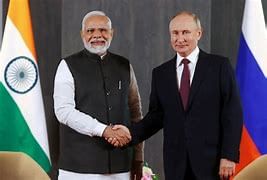
Why in news?
The Indian Prime Minister will be on a crucial 2-day visit to Moscow for the India-Russia annual summit, which has been ongoing since 2000.
First since Russia's invasion of Ukraine:
- This will be the first bilateral meeting between the Indian PM and Russian President Vladimir Putin since Russia's invasion of Ukraine in February 2022.
- The two leaders have met a total 16 times since 2014. The Indian PM last went to Russia for the Eastern Economic Forum meeting in Vladivostok in (Sept) 2019.
- The Russian President last visited India in December 2021 for the annual bilateral summit.
Traditions broken:
- In choosing Russia for his first bilateral visit after being sworn in, the Indian PM has broken with the tradition of India's new PM travelling first to a neighboring country.
- For example, he visited Bhutan in June 2014 and Maldives and Sri Lanka in June 2019.
- He traveled to Italy last month, but that was for a multilateral meeting of G7 leaders.
Significance of the Indian PM's Visit to Russia:
- A foreign policy priority: Russia and India relationship is seven decades old. The USSR era generosity and friendship has been carried over to the relationship with Russia.
- The strategic partnership's strongest pillar is unquestionably defense today, but collaboration in space and nuclear matters is also significant.
- Global significance: Their bilateral meeting comes around the same time as leaders of the 32 nations in the North Atlantic Treaty Organization (NATO) gather in Washington DC to celebrate 75 years of the anti-Russia military alliance.
Key Areas of Engagement Between India - Russia:
- Defence: The USSR was India's main supplier of defense equipment during the decades of the Cold War.
- Today, 60 - 70% of India's defense equipment is estimated to be of Russian and Soviet origin.
- The defense cooperation has evolved over time from a buyer-seller framework to one involving joint R&D, co-development, and joint production.
Oil boost:
- Since the beginning of the war in Ukraine, India has been buying large amounts of Russian oil at a discount to cushion the inflationary impact of rising crude prices.
- In the face of international criticism, the Indian External Affairs Minister reiterated that India would continue to buy Russian oil in the interest of Indian consumers.
Trade:
- The purchase of Russian crude has pushed bilateral trade volumes beyond expectations and targets.
- Before the war, the bilateral trade target was set at $30 billion by 2025. However, bilateral trade reached an all-time high of $65.70 billion in FY 2023-24.
Challenges for India in Maintaining its Ties with Russia:
- Balance of trade heavily in Russia's favor: India's imports from Russia amount to $61.44 billion.
- Walking diplomatic tightrope: New Delhi has not explicitly condemned the Russian invasion but expressed concern over threats of nuclear war issued by Russian leaders.
- Maintaining ties with western nations: The Russia-Ukraine war has put India in a delicate diplomatic position with its Western allies.
Way Ahead for India:
- India's core concern will be its defense relationship with Russia.
- The Moscow-Beijing embrace is against Indian strategic interests.
- Therefore, the Indian PM's visit will seek to strengthen historical ties between the two countries and to ensure that Beijing does not become a factor in the relationship.
GS3/Economy
Crop Insurance Coverage Declines in FY24
Source: Indian Express
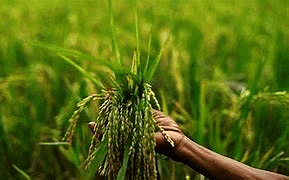
Why in news?
General insurance companies reduced their exposure to crop insurance under the Pradhan Mantri Fasal Bima Yojana (PMFBY) during FY24 despite the government's push to expand the insurance coverage in the farm sector.
Key features of the PMFBY
About:
- A scheme of the Ministry of Agriculture & Farmers Welfare, PMFBY is an insurance service for farmers for their yields, launched in 2016.
- The new Crop Insurance Scheme is in line with the One Nation One Scheme theme.
- The PMFBY replaced the previous two schemes: the National Agricultural Insurance Scheme (NAIS) and the Modified NAIS.
- It has incorporated the best features of all previous schemes while eliminating all previous shortcomings.
Objectives:
- To provide insurance coverage and financial support to the farmers in the event of failure of any of the notified crops as a result of natural calamities, pests and diseases.
- To stabilise the income of farmers to ensure their continuance in farming.
- To encourage farmers to adopt innovative and modern agricultural practices.
- To ensure flow of credit to the agriculture sector.
Premium rates:
- There will be a uniform premium of only 2% to be paid by farmers for all Kharif crops and 1.5% for all Rabi crops (winter sown).
- In case of annual commercial and horticultural crops, the premium to be paid by farmers will be only 5%.
- The balance premium will be paid by the Government (to be shared equally by central and state government).
- The idea is to provide a fully insured amount to the farmers against crop loss on account of natural calamities.
Area based approach:
- The Scheme will be implemented on an 'Area Approach basis,' i.e., Defined Areas for each notified crop for widespread calamities.
- The unit of insurance shall be Village/Village Panchayat level for major crops and for other crops it may be a unit of size above the level of Village/Village Panchayat.
- It is assumed that all insured farmers in a unit of insurance, to be defined as a "Notified Area" for a crop, face similar risk exposures.
No upper limit to subsidy:
- There is no upper limit on Government subsidy. This means, even if the balance premium is 90%, it will be borne by the Government.
Use of technology:
- The use of technology will be encouraged to a great extent. For example,
- Smartphones will be used to capture and upload data of crop cutting to reduce the delays in claim payment to farmers.
- Remote sensing will be used to reduce the number of crops cutting experiments.
Exemptions from tax liabilities:
- There will be exemption from Service Tax liability of all the services involved in the implementation of the scheme.
Beneficiaries to be covered:
- All farmers growing notified crops in a notified area during the season who have insurable interest in the crop are eligible.
- To address the demand of farmers, the scheme has been made voluntary for all farmers from Kharif 2020.
- Earlier, the enrolment was compulsory for farmers who possess a Crop Loan account or Kisan Credit Card (KCC) account, etc).
Risks covered under the scheme:
- Comprehensive risk insurance is provided to cover yield losses due to non-preventable risks, such as Natural Fire and Lightning, Storm, Hailstorm, Cyclone, Typhoon, Tempest, Hurricane, Tornado.
- Risks due to Flood, Inundation and Landslide, Drought, Dry spells, Pests and Diseases will also be covered.
- In cases where the majority of insured farmers in a notified area have intent to sow or plant and have incurred expenditure for the purpose, but are prevented from sowing or planting the insured crop due to adverse weather conditions, indemnity claims up to a maximum of 25% of the sum-insured may be made.
- In post-harvest losses, coverage will be available up to a maximum period of 14 days from harvesting for those crops which are kept in "cut & spread" condition to dry in the field.
- Loss and damage resulting from occurrence of identified localised risks like hailstorm, landslide and Inundation affecting isolated farms in the notified area would also be covered.
Decline in insurance coverage
- In FY24, general insurance companies reduced their participation in the PMFBY despite government efforts to expand farm sector insurance.
- The gross direct premium underwritten declined by 4.17% to Rs 30,677 crore from Rs 32,011 crore the previous year, even as farmers suffered crop losses from adverse weather conditions. This decline followed an 8.66% rise to Rs 29,465 crore in FY23.
- A significant factor was the 32% drop in premium income by the state-owned Agriculture Insurance Company (AIC).
Performance of PMFBY in FY24
- In FY24, the PMFBY scheme covered nearly 4 crore farmers and over 50 crops.
- More than 55% of insured farmers were non-loanee, mainly enrolled through common service centres (CSCs), with 4 crore farmer applications registered.
- To expand PMFBY coverage, the Ministry of Agriculture and Farmer Welfare launched the AIDE (App for Intermediary Enrolment) in Kharif 2023, allowing intermediaries to enrol non-loanee farmers.
- This initiative involved insurance brokers, resulting in 71% of enrolments through Point of Salespersons (PoSPs), covering 6.88 lakh farmer applications and over 4.15 lakh hectares across 11 states and 12 insurers.
GS3/Economy
Digital Bharat Nidhi - Fresh Attempt at Improving Rural Telecom Connectivity
Source: Indian Express
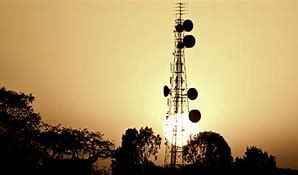
Why in news?
In a fresh attempt at increasing telecom connectivity in rural areas, the Department of Telecommunications (DoT) has released draft rules to operationalise the Digital Bharat Nidhi.
Background - Universal Service Obligation Fund (USOF)
- The USOF was established to provide telecom services in remote and rural areas at affordable prices through a universal access levy, a percentage of revenue earned by operators under various licences.
- In other words, USOF is a pool of funds generated by a 5 percent Universal Service Levy charged upon all the telecom fund operators on their Adjusted Gross Revenue (AGR).
- The goal is to use this money to help expand telecom networks in remote and rural areas.
- Private companies might avoid these areas because they don't make much profit there.
- USOF was given statutory status in December 2003 through amendments to the Indian Telegraph Act (now replaced by the Telecom Act, 2023).
About
- The DBN was established through the Telecommunications Act, 2023.
- It would replace the erstwhile Universal Service Obligation Fund (USOF).
Transfer of funds
According to the Telecom Act, telecom companies' contributions to the Digital Bharat Nidhi (DBN) are:
- First credited to the Consolidated Fund of India (CFI)
- CFI receives all government revenues, including loans and repayments, and covers government expenses.
- The Centre will transfer the collected funds to the DBN periodically.
Fund Utilization
Funds from the DBN will be used to:
- Promote telecommunication services in underserved rural, remote, and urban areas.
- Fund research and development of telecom services, technologies, and products.
- Support pilot projects and provide consultancy and advisory assistance to improve connectivity.
- Introduce new telecom services, technologies, and products.
The DBN will fund projects to provide targeted telecommunication access for underserved groups like women, persons with disabilities, and economically and socially weaker sections.
Appointment of Administrators
- According to draft rules from the DoT, the Centre will appoint an "administrator" to select "DBN implementers" through bidding or applications.
- This administrator will decide how to provide funding on a case-by-case basis, which may include full, partial, or co-funding, as well as market risk mitigation and risk capital.
Telecom services on an open and non-discriminatory basis
- DBN implementers receiving funding must share and provide telecom networks and services on an open and non-discriminatory basis, following the administrator's instructions.
Criteria for schemes and projects funded by the DBN
The schemes and projects funded by the DBN must meet criteria such as introducing:
- Next-generation telecom technologies in underserved areas.
- Improving affordability of services, promoting innovation and research.
- Commercializing indigenous technologies.
- Developing relevant standards, and encouraging telecom start-ups, including equipment manufacturing.
GS-III/Environment and Ecology
Vaquita
Source: NDTV

Why in News?
The world's most endangered marine mammal, the vaquita, is teetering on the edge of extinction.
About Vaquita:
- The vaquita is a shy and the smallest member of the porpoise family, scientifically known as Phocoena sinus.
- Vaquitas are the most endangered marine mammals in the world, with fewer than 20 remaining in the wild.
- They have the smallest range of any whale, dolphin, or porpoise, living only in the northern part of the Gulf of California, which is rich in fish and shrimp.
- Vaquitas are usually found in shallow waters up to 50 meters deep.
- They are the smallest cetaceans, measuring 4 to 5 feet (1.2 to 1.5 meters) long and weighing 65 to 120 pounds (29.5 to 54.4 kg).
- Unlike dolphins, vaquitas have chunkier bodies, rounded heads, and no snouts.
- Vaquitas have no beak, are mostly dark gray with lighter gray undersides, and have black patches on their faces.
- Their dorsal fins are taller and wider than those of most other porpoises.
- A dark ring around their eyes is a distinctive feature.
- Vaquitas are elusive and tend to avoid boats and human activity.
- They communicate using echolocation by emitting high-frequency clicks.
- The population decline of vaquitas is linked to the totoaba, a large fish also found only in the Gulf of California.
- Gillnets illegally set for totoaba are the deadliest for vaquitas due to their similar size.
- Vaquitas are classified as Critically Endangered.
GS-I/History and Culture
 |
Download the notes
UPSC Daily Current Affairs: 8th July 2024
|
Download as PDF |
Key Facts about Shree Jagannath Temple
Source: DNA
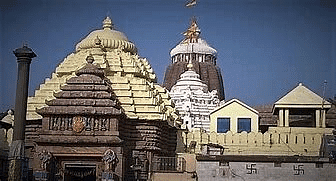
Why in News?
The high-level committee constituted under the chairmanship of the Orissa High Court judge for supervising the inventorisation of valuables stored in Ratna Bhandar of Shree Jagannath Temple has fast-tracked the process of opening the temple treasury after 46 years.
About:
- The Shree Jagannath Temple is a Hindu temple located in Puri, Odisha.
- It is dedicated to Lord Jagannath, a form of the Hindu deity Vishnu.
- It is believed to have been built during the reign of King Anantavarman Chodaganga Deva of the Eastern Ganga dynasty in the 12th century.
Architecture:
- The temple is a striking example of Kalinga architecture, a distinct style in Odisha.
- The temple complex includes shrines, gardens, and sacred tanks.
- The temple’s main structure, the sanctum sanctorum (garbhagriha), houses the idols of Lord Jagannath, Balabhadra, and Subhadra.
- At the pinnacle of the temple, there is a 20-foot-high chakra (wheel) visible from any part of the city.
Ratha Yatra:
The Ratha Yatra is a Hindu festival associated with the Lord Jagannath temple.
The festival commemorates Jagannath's annual visit to Gundicha Temple via Mausi Maa Temple.
It begins on the second day of the bright half of the lunar month of Ashadha (June–July) and lasts for nine days.
During this time, the deities are taken out of the temple and placed on three massive chariots.
The temple is also one of the four sacred pilgrimage sites known as the Chaar Dhaams.
It is a UNESCO World Heritage Site.
GS-III/Environment
Kaziranga National Park
Source: Indian Express
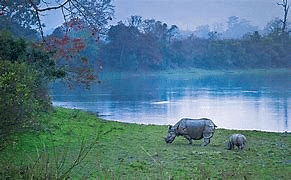
Why in News?
The devastating flood in Assam's famed Kaziranga National Park (KNP) has claimed the lives of 114 wild animals, while 95 others have been rescued recently.
About:
- Location: Kaziranga National Park is situated in the north-eastern part of India, in the districts of Golaghat and Nagaon in Assam.
- It is the largest undisturbed and representative area in the Brahmaputra Valley floodplain.
- The park is home to the world's largest population of one-horned rhinoceroses, along with many other mammals such as tigers, elephants, panthers, and bears, and thousands of bird species.
- Kaziranga was declared a National Park in 1974.
- It is the first national park in Assam and spans an area of 400 sq. km.
- The Diffalu River, a tributary of the Brahmaputra, flows through the park, while another tributary, Moradifalu, flows along its southern boundary.
- In 1985, Kaziranga was declared a World Heritage Site by UNESCO.
Landscape:
- The park features sheer forest, tall elephant grass, rugged reeds, marshes, and shallow pools.
Flora:
- Kaziranga is famous for its dense and tall elephant grasses intermixed with small swamplands.
- It also has an abundant cover of water lilies, water hyacinths, and lotus.
- Rattan cane, a type of climbing palm, is also found here.
Fauna:
- The park is home to many endangered and threatened species like the rhino, tiger, eastern swamp deer, elephant, buffalo, hoolock gibbon, capped langur, and Gangetic River dolphin.
GS-III/Defence and Security
Akash Surface-to-Air Missile (SAM)
Source: MSN
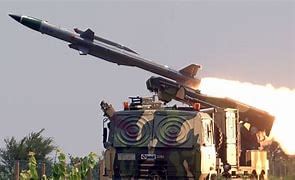
Why in News?
Indian “Iron-Dome” Akash Surface-to-Air Missile (SAM) is competing against Chinese-made Sky Dragon-50 air defense systems to secure an order from Brazil.
About:
- The Akash Surface-to-Air Missile (SAM) is a short-range system designed to protect vulnerable areas and points from air attacks.
- It was indigenously designed and developed by India’s Defence Research and Development Organisation (DRDO) and is produced by Bharat Dynamics Ltd (BDL) in Hyderabad.
- The Akash SAM system can neutralize aerial targets like fighter jets, cruise missiles, air-to-surface missiles, and ballistic missiles.
- It is in operational service with the Indian Army and the Indian Air Force.
Features:
- The missile is 5.8 m long, has a diameter of 350 mm, and a wingspan of 1,105 mm.
- It has a launch weight of 720 kg.
- It can fly at speeds up to Mach 2.5 and has a height ceiling of 18 km.
- The missile can target aircraft up to 45 km away.
- The system’s most important element is the high-power, multi-function Rajendra phased array radar.
- The 3D Passive Electronically Scanned Array Rajendra radar (PESA) can electronically scan and guide the missile towards targets, providing information on the range, azimuth, and height of flying targets.
- The Akash Weapon System can simultaneously engage multiple targets in group mode or autonomous mode.
- It has built-in Electronic Counter-Counter Measures (ECCM) features.
- The guidance system used is command guidance.
- The system is fully automatic, with a quick response time from target detection to kill.
- The entire weapon system is configured on mobile platforms.
- It has an open-system architecture that ensures adaptability to existing and future air defence environments.
|
39 videos|4566 docs|979 tests
|
FAQs on UPSC Daily Current Affairs: 8th July 2024 - Current Affairs & Hindu Analysis: Daily, Weekly & Monthly
| 1. What is the purpose of the Indian PM's two-day visit to Moscow? |  |
| 2. Why is there a decline in crop insurance coverage in FY24? |  |
| 3. What is the objective of the Digital Bharat Nidhi initiative? |  |
| 4. What is the significance of the Vaquita species? |  |
| 5. What are some key facts about the Shree Jagannath Temple? |  |


























